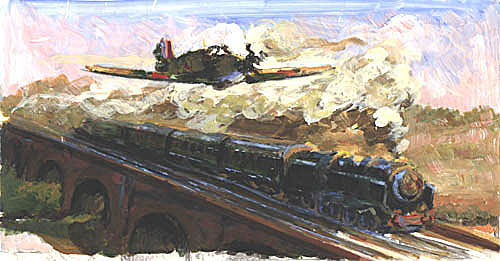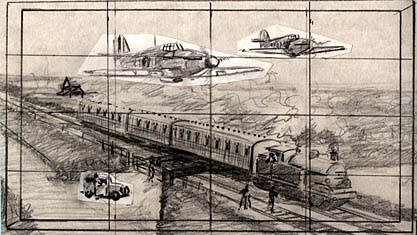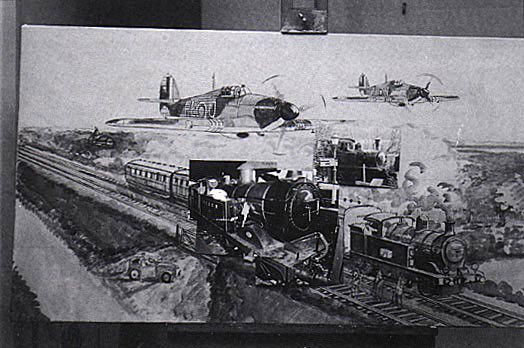
To Paint a Hurricane
First published in Wingspan
"How long did it take you to do it?" is the question most people ask. The answer, of course, depends a lot on the painting and can be anything from five or six days to five or six weeks.
"Really?" They nod thoughtfully, though I'm never quite sure whether they're impressed - imagining that it couldn't be done in less time than it took Michelangelo to paint the Sistine chapel - or amazed that I should spend so much time on something that ought to be finished in an afternoon. Either way, I am only talking about the physical act of painting. It's when I go on to explain the amount of research and planning that goes into each one that they often show surprise. "That would make quite a detective story!" was one reaction. Well...perhaps it would - so here goes.
The story of "Hurricane!" began just before Christmas 1991. I usually plan to publish one aviation print a year and had pretty well decided on a Lancaster for 1992 when I received a phone call from a friend and fellow aviation enthusiast.
"You should talk to a friend of mine, Frank Twitchett" he said after I had mentioned a desire to do a Hurricane some time in the future. "He flew hurricanes during the Battle of Britain. I'm sure he'd be happy to talk to you."
I wasn't so sure. Like most people (other than double glazing salesmen) I always feel terribly awkward phoning total strangers and taking up their time - and this was a Battle of Britain pilot! I had visions of someone sounding like Sir Lancelot Spratt chewing me out for having the temerity to telephone. Still, nothing ventured nothing gained. Plucking up my courage I contacted him that evening and, of course, my fears couldn't have been further from the truth.
He was a smashing bloke. We had a long chat about his wartime exploits and he seemed genuinely enthusiastic about the prospect of having one of them turned into a print - even when I explained that it wouldn't come to fruition for two years!
For some time I had had an idea percolating around in the back of my mind for a picture combining an aeroplane and a train. No real reason, it just seemed to offer such wonderful possibilities. Well, somehow we got onto the subject of railways. This wasn't such a coincidence since I later found out that Frank has a passion for them that even outstrips his interest in aeroplanes! So when he told me how they would often use the line between Ashford and Redhill to navigate their way home the idea just clicked!
The following week had already been ear-marked for sketching out ideas and doing research for the Lancaster, but I found myself continually drawing Hurricanes flying this way and that over every conceivable piece of railway rolling stock. Studies of Lancs I'd made suddenly found themselves flying over bits of railway, then, metamorphosing suddenly, with the aid of an eraser, into Hurricanes. Finally the day came when I went to the library for information on Bomber Command and came away with an armful of books on Kent and Surrey railways!
I gave in, put away the drawings for the Lancaster and phoned Frank.
With the aid of several learned tomes I began to acquaint myself with the aeronautical history of the Southern Railway (as it was in those days).
The line between Ashford and Redhill is exceptionally straight, a feature that makes it easily identifiable from the air, and therefore a valuable navigational aid since the earliest days of aviation. Pilots flying between Paris and London used it, marking their progress by the stations which had their names painted on their roofs for that very purpose.
Later, Frank and his fellow pilots would have to do without such considerate touches. In 1939 the roof top information went the same way as the road signs and platform station names. But despite this, the black-out, and the thick blue paint that covered the station lamps, the bright silver rails shining in the evening light still showed the way. Little wonder that some pilots named it 'The Way Home'.
Several days later a letter arrived from Frank giving details of the plane he had flown along with a photograph of a group posing in front of one of the squadron's Hurricanes.
Frank Twitchett joined 229 Sqn. in October 1940. Later posted to 145 Sqn. he would share credit in downing a Ju88 in March 1941 and destroy a Bf109 over the Western Desert in June 1942. But in the final days of the Battle of Britain he flew 229 Sqn Hurricane RE-Q, airframe number V7245.
Using the aircraft number as a starting point I tried to find out what had happened to it after it left Frank's gentle care.
Enquiries began at the Imperial War Museum Library.
I love this place and use it a lot. With it's reading tables set in circles it reminds me of a tiny version of it's more famous counterpart in the British Museum. Even getting to it is an experience. You have to book in advance and, after reporting to reception, you are escorted up in a lift then led through corridors crammed with filing cabinets and looking every bit like secret service headquarters a la John le Carre, until you finally reach your seat where your requested books are already neatly piled on the table. Pure bliss!
Unfortunately this particular quest proved fruitless so, rather than waste the trip, I spent the time looking up bits and pieces for future projects and came away with quite a lot of information on Suffolk coastal defences, one of the more interesting pieces being that the gaily coloured Victorian bathing huts at Southwold, fairly famous locally, were towed off and strewn around the common to prevent German gliders landing. I'm almost sorry they never came - there would have been a great picture in it.
The R.A.F Museum Library at Hendon lacks the old world charm of the IWM but is very useful nonetheless (this was written in the days before cutbacks made the waiting list to use the facilities months rather than days - and therefore fairly useless). But still I could turn up nothing other than the manufacturing details.
Mark 1 Hurricane, V7245, was built as part of a batch of 500 by Hawker aircraft between July 1940 and February 1941. By October 1940 it was in service with 229 Sqn. But what happened to it after that seems unknown and as it's fate had no bearing on the painting I gave up any further enquires along that line.
The next major headache turned out to be the location. This was to be an interpretation of an actual event. I stress the word interpretation because on seeing the finished painting Frank confirmed that although in those days low flying was not forbidden and only punished if reported as dangerous, he couldn't help wondering if he'd ever really flown that low. I can only claim artistic licence but, having got to know him over the last 18 months I wouldn't mind betting that if anyone did, it would have been him.
However, I did want the setting to be absolutely authentic. No problem, surely?. Redhill is only just down the road and I was sure that the idyllic little country halts I had been drawing from imagination would spring into view the moment the train left the station.
To be fair, it was a dismal January day when the train pulled out of Redhill, but as I sat by the window with my ordnance survey map and Middleton Press' Ashford to Redhill open on my lap, I grew gradually more despondent as characterless station after characterless station passed by. Much of it, no doubt, due to 'modernisation'. Old photographs taken in pre-concrete block days, gave glimpses of promising looking stations along the route and with a bit of digging in the archives I might have found enough detail to have reconstructed it as it was in 1940 but by the time I got to Ashford I had already talked myself out of the idea. "It was too crowded anyway, All roofs and clutter. No good at all. Open countryside - with a few figures - that would be just the thing!"
On the way back I noticed the bridge that carries the line over the Penshurst canal just outside leigh and instantly knew it was what I needed. A drive down to photograph the bridge the following day, a quick delve into the history of the canal, more sketches, more colour sketches - this was surely going to be wonderful!

Colour sketch in acrylic of the bridge idea
IThe euphoria lasted a week before the doubt crept in. The bridge wasn't interesting enough for the amount of space it took up. The figures fishing from the bank were too small because of it's height.....
What would really look good, I thought, would be a level crossing. A nice little car perhaps, some people working on the line. Out came the ordnance survey maps again, and in what seemed a perfect example of sod's law, there didn't seem to be a single one. Bridges - plenty. Tunnels - dozens. A couple of foot crossings but nothing that you could take a 'nice little car' across.
In desperation I rechecked it and with a sigh of relief I found what appeared to be the one and only level crossing on the entire line. Disused, but a crossing all the same.
I drove down to have a look and found it looked very little like the crossing I had envisaged but a call to the local history society put me in touch with several people who could remember what it looked like back in '40, and one man in particular who regularly drove his car over it during that period.

Compositional drawing in pencil. The aircraft and car are on separate pieces
of
paper allowing them to be moved into the most suitable position.
The little car was a doddle - A friend owns a 1935 Austin Ruby and a photo taken of it outside his house while I hung out of his bedroom window clinched it.
Research into weather conditions for the period was more successful. Frank had joined 229 Sqn with the rank of Sergeant, and being one of the more junior pilots he had to take whichever aircraft was available on the day, but he supplied me with a couple of dates that he knew for certain that he'd flown this particular aircraft, these being the weekend of 26 and 27 October. The Saturday was interesting from the point of view of documentation. Three Bf 109s of JG53 were shot down over the Channel by 92 Sqn and 229 Sqn attacked a rescuing Heinkel Seaplane, shooting it down but at a cost of two of the squadron's Hurricanes. This would have made an interesting tit bit to put in the fact sheet which accompanies the print but as I really wanted to have my Hurricanes flying over the railway on a nice bright Autumn day, Saturday, being wet and cold, was out.
The following day Hawkinge was bombed and eight Messerschmitts were downed. The weather generally was poor but there were bright periods locally so Sunday the 27th it had to be.
All that remained was to investigate relevant aspects of the Southern Railway - a task that was harder and more full of pitfalls than all the rest of it put together - but which is probably more suited to a steam enthusiast magazine than here.

The canvas is underpainted in brown acrylic. Reference photo's
have been taped on prior to working on the engine.
After the print had been run and the sheet detailing all the elements of the picture had been printed,
I sent a couple of copies to the Headcorn Local History Society by way of thanks. Some weeks later I got a letter from one of the ladies I had spoken to who wrote ".....Such a splendid reminder of the war years here. Your little red motor-car reminds me of the one owned by the German spies who lived just down the road and who made such a hasty exit when Lord Haw Haw made references to Headcorn on the radio....."
I wish I'd known that!
![]()
![]()
![]()
![]()
![]()
![]()
![]()